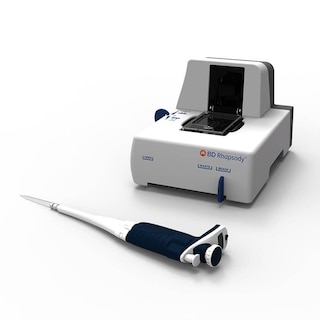-
Your selected country is
Middle East / Africa
- Change country/language
Old Browser
This page has been recently translated and is available in French now.
Looks like you're visiting us from {countryName}.
Would you like to stay on the current country site or be switched to your country?


Oligo Mouse Anti-Human CD93
Regulatory Status Legend
Any use of products other than the permitted use without the express written authorization of Becton, Dickinson and Company is strictly prohibited.
Preparation And Storage
Recommended Assay Procedures
Put all BD® AbSeq Reagents to be pooled into a Latch Rack for 500 µL Tubes (Thermo Fisher Scientific Cat. No. 4900). Arrange the tubes so that they can be easily uncapped and re-capped with an 8-Channel Screw Cap Tube Capper (Thermo Fisher Scientific Cat. No. 4105MAT) and the reagents aliquoted with a multi-channel pipette.
BD® AbSeq tubes should be centrifuged for ≥ 30 seconds at 400 × g to ensure removal of any content in the cap/tube threads prior to the first opening.
Product Notices
- This reagent has been pre-diluted for use at the recommended volume per test. Typical use is 2 µl for 1 × 10^6 cells in a 200-µl staining reaction.
- Source of all serum proteins is from USDA inspected abattoirs located in the United States.
- Caution: Sodium azide yields highly toxic hydrazoic acid under acidic conditions. Dilute azide compounds in running water before discarding to avoid accumulation of potentially explosive deposits in plumbing.
- The production process underwent stringent testing and validation to assure that it generates a high-quality conjugate with consistent performance and specific binding activity. However, verification testing has not been performed on all conjugate lots.
- Illumina is a trademark of Illumina, Inc.
- Please refer to http://regdocs.bd.com to access safety data sheets (SDS).
- Please refer to bd.com/genomics-resources for technical protocols.
- For U.S. patents that may apply, see bd.com/patents.
Companion Products






The R139 monoclonal antibody specifically binds to CD93 which is also known as Complement component C1q receptor (C1qR), C1q receptor 1 (C1qR1), or Matrix-remodeling-associated protein 4 (MXRA4). The immunogen used to generate the R139 hybridoma was a preparation of CD93 protein. Human CD93 is a transmembrane glycoprotein that is highly expressed on monocytes, macrophages, granulocytes, and endothelial cells but not on T and B lymphocytes. CD93 is also known as the C1q/MBL/SPA Receptor as it binds C1q, the recognition subunit of the first component (C1) of the complement pathway, as well as MBL (Mannose-binding-lectin) and SPA (Pulmonary Surfactant Protein A). Human C1qRp is involved in the C1q-mediated enhancement of phagocytosis. R139 is suitable to detect CD93 expression on cells of myeloid lineage by flow cytometry, and CD93 in cellular lysates by Western blotting or immunoprecipitation. In addition, R139 reportedly neutralizes C1q-mediated enhancement of phagocytosis. CD93 has also been reported to define a human stem cell population with hematopoietic and hepatic potential.
Development References (7)
-
Danet GH, Luongo JL, Butler G, et al. C1qRp defines a new human stem cell population with hematopoietic and hepatic potential.. Proc Natl Acad Sci USA. 2002; 99(16):10441-5. (Biology). View Reference
-
Guan E, Robinson SL, Goodman EB, Tenner AJ. Cell-surface protein identified on phagocytic cells modulates the C1q-mediated enhancement of phagocytosis. J Immunol. 1994; 152(8):4005-4016. (Immunogen: Bioassay, ELISA, Flow cytometry, Immunoprecipitation, Inhibition, Neutralization, Western blot). View Reference
-
Guan EN, Burgess WH, Robinson SL, Goodman EB, McTigue KJ, Tenner AJ. Phagocytic cell molecules that bind the collagen-like region of C1q. Involvement in the C1q-mediated enhancement of phagocytosis. J Biol Chem. 1991; 266(30):20345-20355. (Immunogen: Functional assay, Immunoprecipitation, Inhibition, Western blot). View Reference
-
Nepomuceno RR, Henschen-Edman AH, Burgess WH, Tenner AJ. cDNA cloning and primary structure analysis of C1qR(P), the human C1q/MBL/SPA receptor that mediates enhanced phagocytosis in vitro. Immunity. 1997; 6(2):119-129. (Clone-specific: Western blot). View Reference
-
Nepomuceno RR, Ruiz S, Park M, Tenner AJ. C1qRP is a heavily O-glycosylated cell surface protein involved in the regulation of phagocytic activity. J Immunol. 1999; 162(6):3583-3589. (Clone-specific: Flow cytometry, Functional assay, Immunoprecipitation, Inhibition). View Reference
-
Nepomuceno RR, Tenner AJ. C1qRP, the C1q receptor that enhances phagocytosis, is detected specifically in human cells of myeloid lineage, endothelial cells, and platelets. J Immunol. 1998; 160(4):1929-1935. (Clone-specific: Flow cytometry, Immunoprecipitation). View Reference
-
Tenner AJ. C1q receptors: regulating specific functions of phagocytic cells. Immunobiology. 1998; 199(2):250-264. (Biology). View Reference
Please refer to Support Documents for Quality Certificates
Global - Refer to manufacturer's instructions for use and related User Manuals and Technical data sheets before using this products as described
Comparisons, where applicable, are made against older BD Technology, manual methods or are general performance claims. Comparisons are not made against non-BD technologies, unless otherwise noted.
For Research Use Only. Not for use in diagnostic or therapeutic procedures.
Report a Site Issue
This form is intended to help us improve our website experience. For other support, please visit our Contact Us page.